Aloe Vera: Soothing the Burns of Desert Cities
The most common reason that Aloe Vera is purchased is to soothe sunburns, but it has a number of valuable properties beyond sunburns and decor. In addition to numerous conventional uses, my grandmother also taught me many of the unconventional uses for Aloe Vera, which she called sabila; she described to me how natural Aloe Vera was used for rashes, infections, and could even be used as a substitute for toothpaste, if necessary.
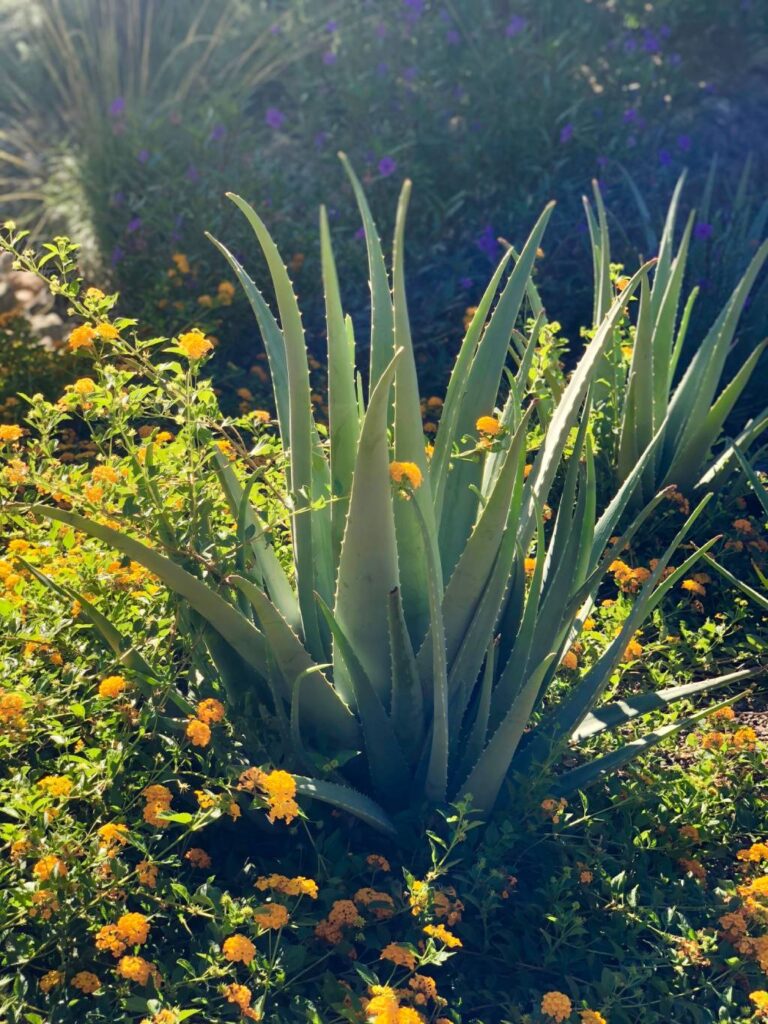
Aloe Vera at ASU Tempe Campus Photo Credit: Brigitte Hernandez
The first time that I can remember using Aloe Vera as a healing tool was when I was seven years old,
and very excited for my picture day at school. I remember picking out the perfect dress the night before and leaving it laid out for the next morning; unfortunately for me the next morning was overcast and rainy, which meant that I had to trade in my dress for a blue, long sleeved shirt that desperately needed to be ironed. By the time my mom was done ironing my shirt, I was so excited to grab it that I leaned up on the face of the hot iron to reach it. I instantly regretted my actions but it was already too late, I felt the white hot pain from the iron and I had an angry red burn across the palm of my hand. To make matters worse, my mom said I was going to have to miss picture day to get the burn checked out. Luckily for me there was another option: the Aloe Vera tree in my backyard. My grandmother quickly suggested this and went to the Aloe Vera tree to cut a single branch a few inches from the root; the house was filled with a smoky scent as she heated up the Aloe Vera on the stove before spreading the warmed gel from the leaf across my palm. Despite the fact that the Aloe Vera had been warmed, I instantly feel a cooling relief on my hand as the Aloe Vera soothed the burn. After letting the Aloe Vera have its effect for what felt like ages, my grandmother wrapped my hand with some of the Aloe Vera left spread across my palm and I was able to make it on time to take my picture for the school yearbook.
Aloe Vera is regularly used to soothe burns and can be used both naturally and after being processed. Some uses of Aloe Vera include, but are not limited to: shampoos, moisturizers, and a number of make-up products. The most common places in which Aloe Vera can be seen is outside buildings, along hiking trails, or in botanical gardens, providing the perfect aesthetic of a desert garden plant, especially in desert cities and campuses. Aloe Vera is as beautiful as it is useful, but while it is regularly used as an adornment, its practical applications are being overlooked.
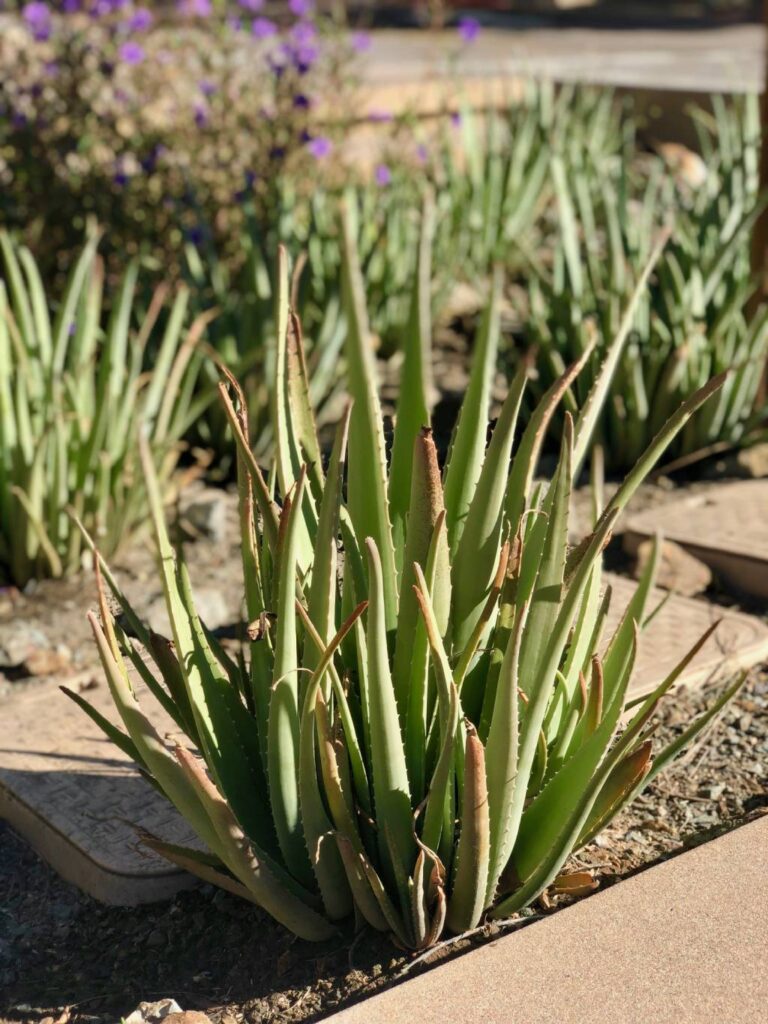
Aloe Vera at ASU Tempe Campus Photo Credit: Brigitte Hernandez
Phoenix is a model for understanding the ways in which desert cities have room for growth in relation to the ways in which they practice sustainability. Within the greater Phoenix area, the ASU Tempe campus has found a niche in which the campus is making great strides in sustainable advancements and technologies; despite this success academically, the campus fails to apply these advancements on their largest and most visited campus. Both Bird on Fire: Lessons from the World’s Least Sustainable City, written by Andrew Ross, and Lyanda Lynn Haupt’s The Urban Bestiary serve as “seeing instruments” (Adamson, 136) to further the understanding of the ways in which sustainable practices in desert cities are withering rather than thriving, because natural species and resources, like Aloe Vera, are being overlooked. The Aloe Vera plant is the perfect example of this and is greatly overlooked and undervalued in desert cities, it serves as one such seeing instrument and it exemplifies the changes that have been made to the relationship between humans and their environment.
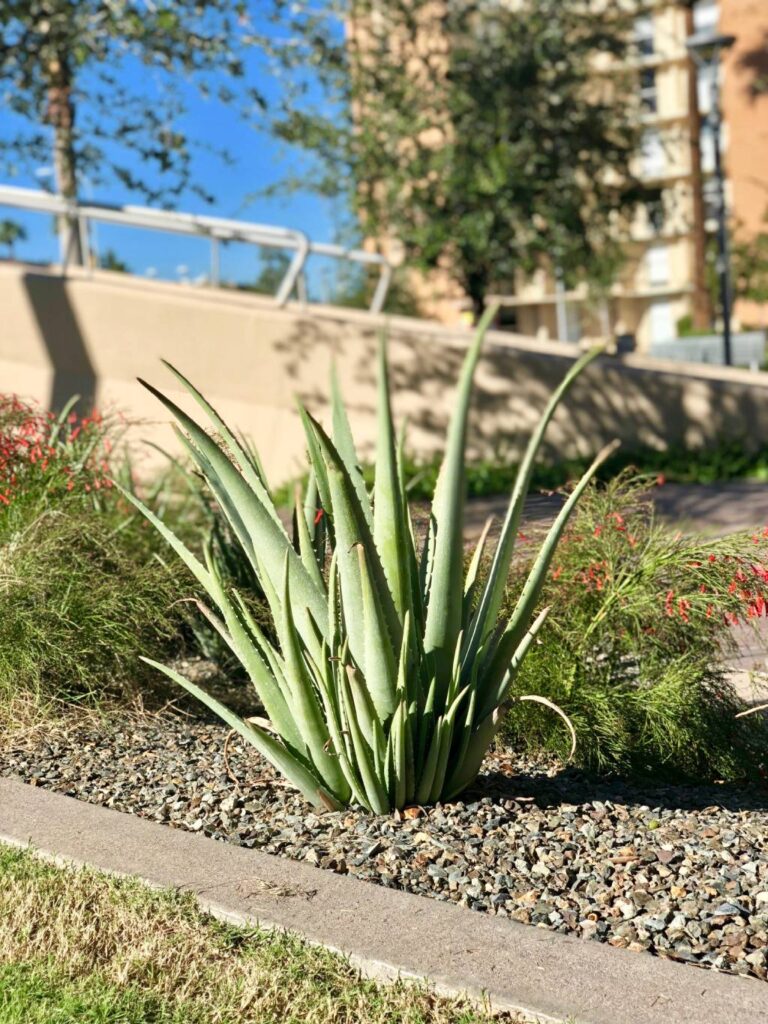
Aloe Vera at ASU Tempe Campus Photo Credit: Brigitte Hernandez
Aloe Vera is crucial to a more sustainable urban environment because of the potential changes that it exemplifies. Joni Adamson “suggested the phrase ‘seeing instrument,’ long associated with the Popol Vuh, to describe” the ways in which “humanities scholarship” and environmental factors can be used to make “complex connections between biogeochemical processes and the ‘well-being’ of all life on the planet more visible to a broad general public,” (Adamson, 136). The Aloe Vera plant serves a seeing instrument that demonstrates the strides that have already been taken in the progression of making urban life more sustainable, as well as the changes that have yet to be made.
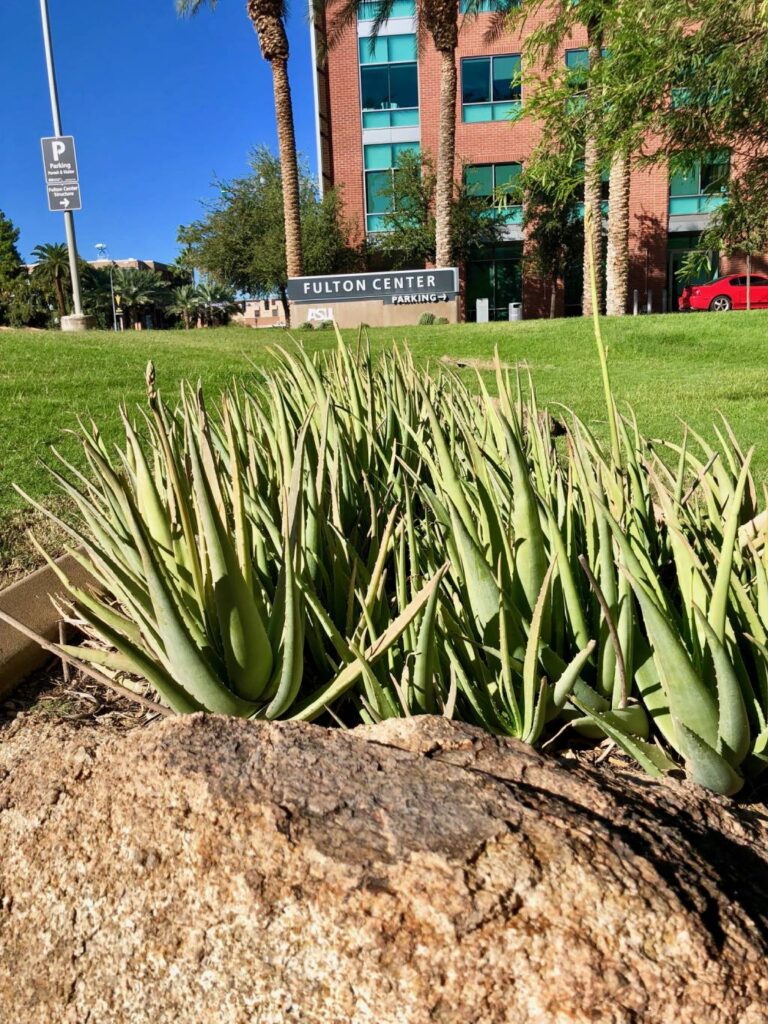
Aloe Vera at ASU Tempe Campus Photo Credit: Brigitte Hernandez
Aloe Vera highlights the ways in which the understanding of nature and sustainability must continue to evolve in order to lead desert regions towards “a future we want.” “A Future We Want” is not only a concept for a more sustainable future, but also a document created at the Rio+20 United Nations Conference on Sustainable Development, which was held in Rio de Janeiro in 2012. Within this document, the United Nations renewed their “commitment to sustainable development and to ensuring the promotion of an economically, socially and environmentally sustainable future for our planet and for present and future generations.” One location where this statement can have a significant impact is Arizona State University, which is looked at as the leading university in innovation and as having one of the most advanced sustainability programs across the country. Despite this, Andrew Ross highlights both the successes and the shortcomings that ASU has in regard to sustainability in his book Bird on Fire: Lessons from the World’s Least Sustainable City. While Ross focuses primarily on the ways in which the ASU downtown campus can serve as an example for urban desert communities, he fails to reflect on the ways in which the ASU Tempe campus is failing in terms of sustainability. The Tempe campus at ASU is by far is the largest and most visited campus but compared to the downtown and polytechnic campuses, which are more rarely visited, it is the least sustainable by far. Despite the ways in which the ASU Tempe campus is overlooked, Ross’s work as well as other works of ecoliterary criticism highlight the ways in which changes have been made. The Rio+20 United Nations Conference on Sustainable Development was held only a year after Ross’s Book was published, illustrating the ways in which ecoliterary criticism has made a difference to the understanding of sustainability in urban desert environments.
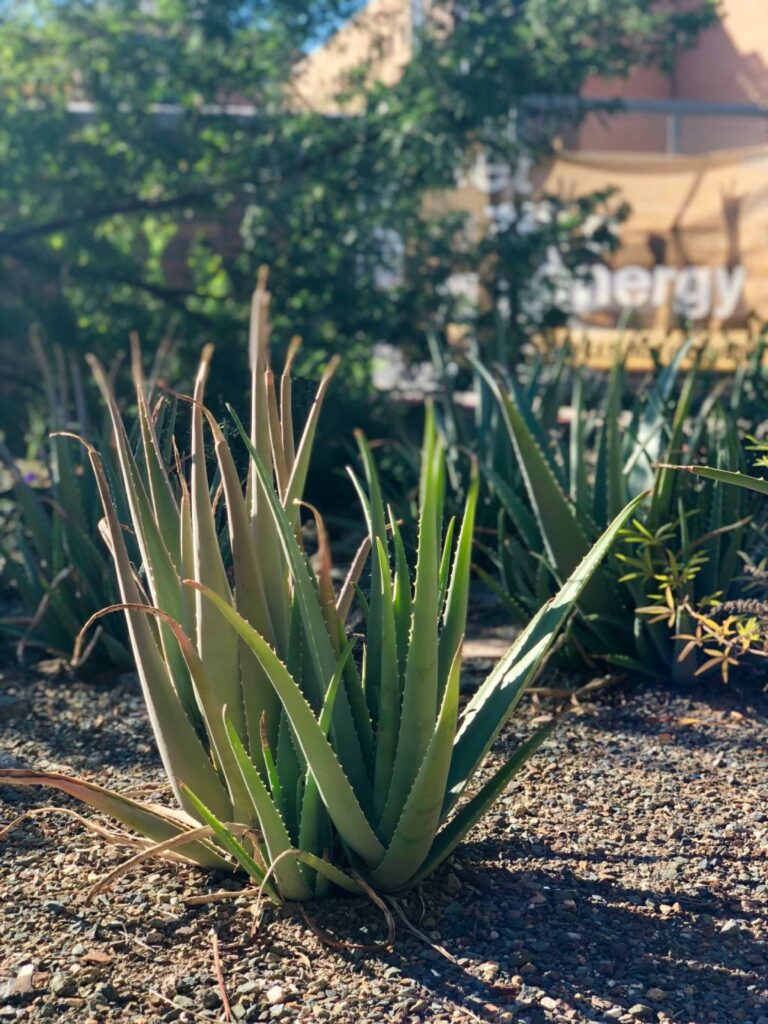
Aloe Vera at ASU Tempe Campus Photo Credit: Brigitte Hernandez
Ross’s work emphasizes the ways in which ASU fails to meet the standards that they claim as well as the impact this has on desert cities as a whole. This is more specifically notable through the manipulation of Aloe Vera for aesthetic purposes; it is used as a decorative plant to create variety amongst the cacti
that make up much of the plant life across Tempe, despite the many uses that Aloe Vera has. Although Arizona state University, specifically the Tempe campus, is only one small region in a vast desert area, it is often looked at as a model for desert communities because of the desert landscaping across the campus. Shifting ASU campuses to reflect the Polytechnic campus would have a significant impact on making ASU more sustainable as a whole. One of the primary ways in which the Polytechnic campus demonstrates superior methods of sustainability is through the ASU Polytechnic community garden, which “helps students understand food systems, waste management, electricity and water conservation in the desert,” (ASU Now: Growing Sustainability at Polytechnic Campus). Much like the rest of the Polytechnic campus, the ASU Polytechnic community garden “itself is a model of sustainability,” (ASU Now: Growing Sustainability at Polytechnic Campus) and introducing the sustainable practices found on the Polytechnic campus to the Tempe campus would create a more widespread understanding of sustainability at ASU, rather than hiding innovative knowledge on one of the least visited ASU campuses.
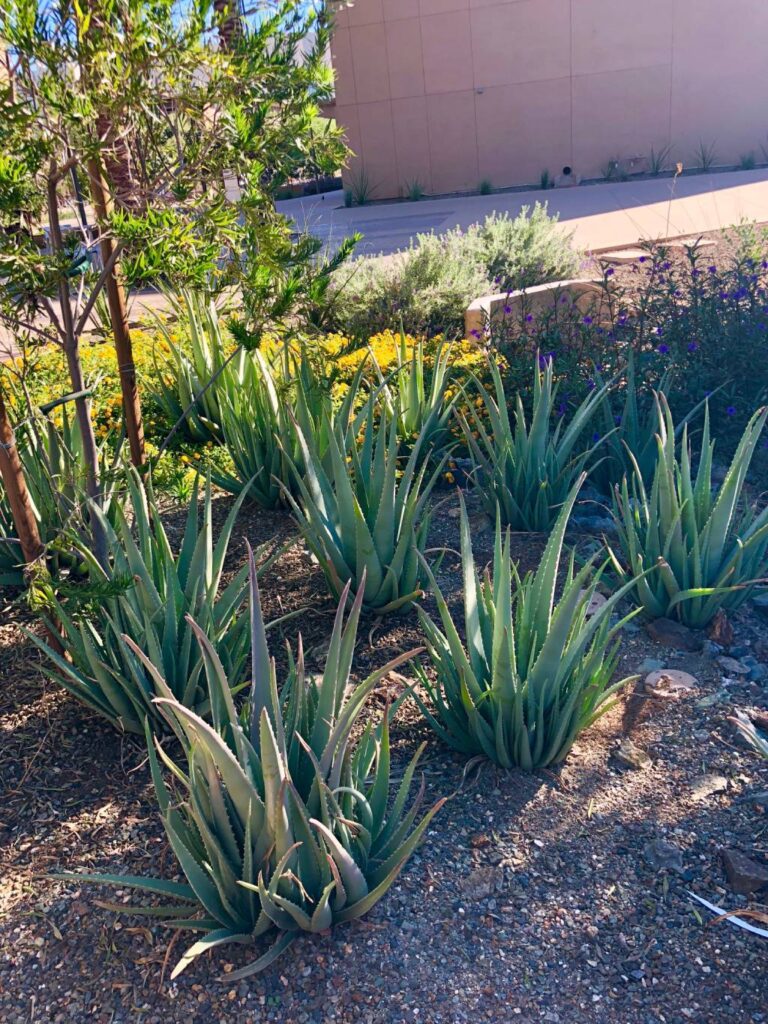
Aloe Vera at ASU Tempe Campus
Photo Credit: Brigitte Hernandez
Despite the fact that the Tempe campus is not the most sustainable at ASU, “Arizona State University continues to make progress in sustainability ratings. ASU was recognized as No. 5 overall by the Sierra Magazine Cool Schools report and a top performer in the 2018 Sustainable Campus Index, achieving a No. 7 overall rating,” (ASU Now: ASU is Top Performer in 2018 Campus Sustainability Ratings). While the use of desert plants, such as Aloe Vera, can be seen in certain areas within the campus, the most successful way to ignite change would be if “ASU would take the whole metropolitan region as its laboratory, a badly damaged environment on which [its] researchers would be set loose to patch, heal, and relaunch as something more like an urban ark,” (Ross, 175). A complete relaunch of the ASU Tempe campus has the potential to create a new, fully sustainable community in which the existing sustainable technologies could inspire future innovation for the progression of sustainable advancements. Not only would this change the way that ASU understands sustainability, but valuing “common species” such as Aloe Vera could change the concept of desert living and shift it to an urban lifestyle that is less wasteful and more practical long-term.

Aloe Vera at ASU Tempe Campus
Photo Credit: Brigitte Hernandez
Lyanda Lynn Haupt’s The Urban Bestiary captures the value of common species, like Aloe Vera, and the hidden value that they hold. Haupt begins by pointing out that while “certainly knowledge about all earthen creatures is wonderful and essential… very often we know a great deal more about the Chinese giant panda or the lowland mountain gorilla than we do about the most common of local creatures, say the eastern gray squirrels in our backyards,” (Haupt, 8). In the face of this perceived division between urban life and nature, “few serious efforts have been made to slow down the evident worldwide denaturalization of nature” (Castree, 152). Thoughts regarding the preservation of nature often include organizations that are saving dolphins or polar bears, but rarely do individuals consider indigenous plants as something that might be threatened by human activity. Saving polar bear pups appears more urgent than saving Aloe Vera pups, but protecting local species can potentially have a greater impact than simply making efforts to conserve and protect endangered species that have a certain aesthetic. The Urban Bestiary draws focus to the ways in which the connections between nature and urban living have remained constant. Lyanda Lynn Haupt emphasizes the significance of nature and the ways in which it plays a more serious role in urban life.
Aloe Vera creates a perfect marriage between the ideas of urban living and nature, it is an easily sustainable plant, making it a great contribution to urban desert communities and has a number of health benefits that are vastly overlooked. My grandmother adds Aloe Vera to her diet every day as a part of her green smoothie containing parsley, cucumber, celery, apple, lemon, pineapple, ginger and tomato to take advantage of these health benefits. She takes a four-inch piece from the root of an Aloe Vera branch at the thickest point and adds the gel-like substance that can be found within the leaf to her smoothie. The introduction of local plants to diets in urban desert communities can introduce a rectified and more successful relationship with nature, and can lead to more advanced and sustainable lifestyles in which nature and urban living coincide. The relationship between nature and urban living can be advanced in simple ways, such as simply recognizing the potential attributes of plants like Aloe Vera that are sitting just outside an office window.

Aloe Vera at ASU Tempe Campus
Photo Credit: Brigitte Hernandez
When looking at nature as a whole, and Aloe Vera more specifically, the definitions of what “urban” and “nature” mean must be determined. Natural and urban are usually considered two extremes on a single spectrum on which the idea of nature is tied to the past and the idea of urban living is tied to advancements, but the two concepts are not mutually exclusive. Rather, they are two intertwined ideas that exist in a mutualistic relationship. Allowing one to thrive strengthens the other, but cutting one off with surely end them both. Understanding nature in the Anthropocene means becoming aware that while the antiquated idea of nature being untouched by man can no longer exist, nature remains ever-present and continues to evolve as a part of each new advancement in urban desert communities. The ASU Polytechnic campus exemplifies how urban life can thrive alongside nature; through many sustainable practices, “it opens the minds of students to what it means to eat local, what it tastes like and, why it is important,” (ASU Now: Growing Sustainability at Polytechnic Campus). Applying the innovative and sustainable practices seen at the ASU Polytechnic campus across all of the ASU campuses could reintroduce sustainable concepts to ASU and make ASU the model for what sustainably should look like in desert communities. Aloe Vera is already seen across the ASU Tempe campus and understanding and applying its uses more practically can be the first step towards making the ASU Tempe campus as sustainable as the ASU Downtown and ASU Polytechnic campuses.
One of the primary ways in which cities must shift in order to become more sustainable is through the ways in which nature is presented in urban communities. There are progressively fewer areas in which a community can be found to have indigenous plant life or other forms of indigenous wildlife. More often than not, plants or animals that belong in a region are overcome by invasive species or removed because they do not suit the image of an urban lifestyle. In order to take steps in correcting this relationship with nature, individuals must decide if “the death of nature” is “real or exaggerated, a matter of degree or kind,” (Castree, 152). If the link between urban life and nature is to be corrected, individuals must actively demand and create change in their own communities; in order to create change, great strides must be made in terms of social cooperation as much as scientific discovery. ASU is already one of the most sustainable universities across the nation, but rather than looking at this success as a stopping point, ASU should strive to continually reach new levels of sustainable advancement. To achieve even greater sustainable success, ASU needs only to apply the knowledge and technologies that it already holds across all of its campuses. Introducing a community garden containing Aloe Vera and other desert plants to the Tempe campus would introduce a more well-rounded understanding of sustainability to a much larger audience. Rather than hiding successful projects such as the ASU community garden in locations where few students can see it, projects such as these should be introduced where they can reach the most people.

Aloe Vera at ASU Tempe Campus
Photo Credit: Brigitte Hernandez
The first concept that must be accepted in order for a sustainable way of urban living to exist is to create a balance between urban technologies and natural landscaping. The manipulation of land surfaces in urban communities can cause urban heat island effect, which essentially increases the temperature in urban cities because of modifications made that remove vegetation from urban areas. Maintaining succulents such as Aloe Vera, which require watering only once every one to two weeks, can be one way that this effect can be minimized without requiring extensive amounts of water to maintain plants that could not otherwise survive in the desert. Living within ecosystem limits is arguably the most significant change that could be introduced to desert cities because of the vast quantity of finite resources that respecting ecosystem limits could potentially conserve. Demands for water, energy, fuel and countless other resources could be reduced significantly if large cities were shaped to the demands of the planet, rather than constantly attempting to shape the planet to urban lifestyles. Applying biological knowledge about plant life and adapting it to urban living is a primary way in which individuals can act locally and think globally to make significant changes to the wasteful standards that are currently set in place in most urban cities. With its many benefits outside being a garden plant Aloe Vera can be of great use and limit the need for the need for increasingly harmful chemicals, and it can already be found growing in front of office windows across the South West. Considering the significance of this natural resource draws into question what the role of plants is in modern urban desert communities.
Plants in desert cities can be found in grocery stores, gardens, and parks; ultimately, they exist to provide a food source and to create an aesthetic. Whether or not this is the purpose of plants in modern communities has yet to be determined. There is a clear division between plants that can be used as a food source and those that serve alternative purposes, but this is not a practical way of thought when a single plant can have seemingly infinite functions. Deciding that a specific species that can be found in gardens, like Aloe Vera, is not meant to be consumed becomes much less rational after realizing that it can be used to soothe stomach aches. Having Aloe Vera in a medicine cabinet becomes a luxury when it is made clear that it can be used to strengthen hair and clear and moisturize skin. Limiting the use of plants so that only one facet of a given species is put to use is as impractical as it is unsustainable. With these properties in mind, it is necessary to reestablish the role of plants in urban desert communities and consider why the role of overlooked plants matters. Aloe Vera is incredibly easy to grow because its pups, or newly sprouted Aloe Vera trees, can easily be removed from alongside the mother plant or simply grow beside it. The Aloe Vera tree in my backyard continues to thrive and my grandmother continues to grow and use these Aloe Vera plants. Much like Aloe Vera pups, the knowledge and ability to practice sustainable living can easily spread from home to home and eventually create a superior way of urban living and “a future we want.”
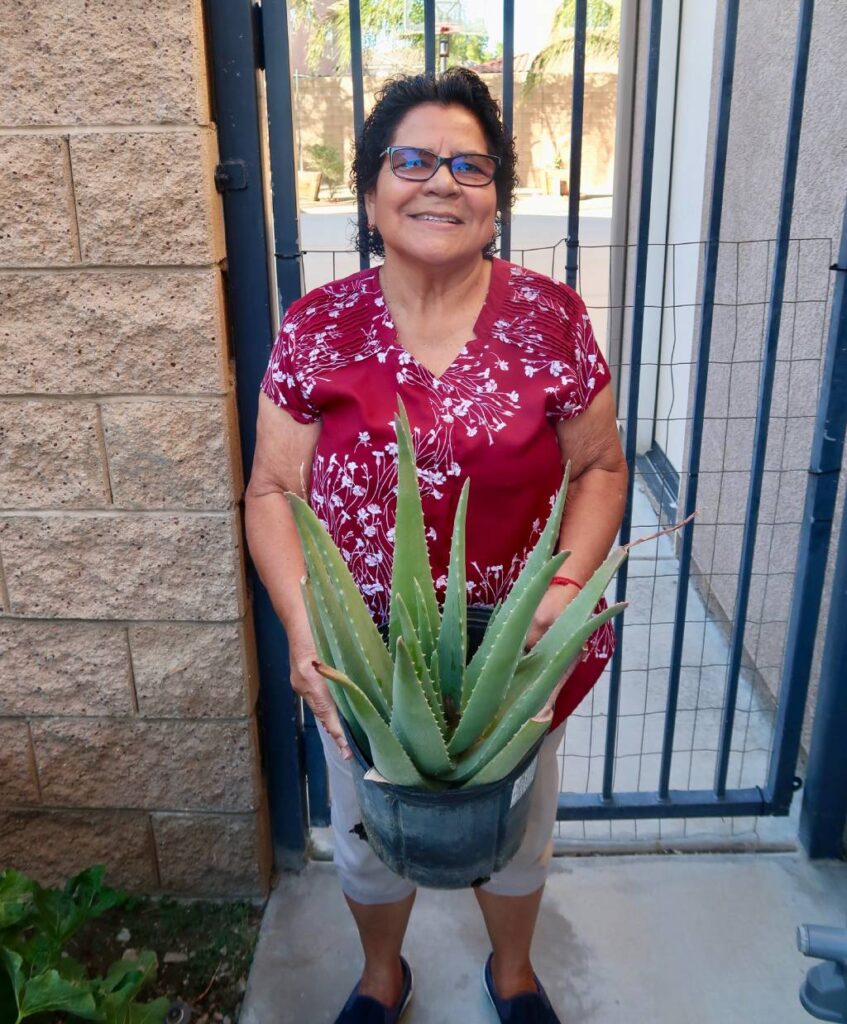
Ana Portillo holding one of her Aloe Vera plants in Eastvale, CA
Photo Credit: Brigitte Hernandez